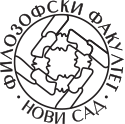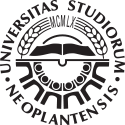15EM004 - Cognitive Development
| Course specification | ||||
|---|---|---|---|---|
| Course title | Cognitive Development | |||
| Acronym | 15EM004 | |||
| Study programme | English Language and Literature | |||
| Module | ||||
| Type of study | ||||
| Lecturer (for classes) | ||||
| Lecturer/Associate (for practice) | ||||
| Lecturer/Associate (for OTC) | ||||
| ESPB | 6.0 | Status | ||
| Condition | Pragmatics | Oblik uslovljenosti | ||
| The goal | Students should gain theoretical and practical knowledge about the cognitive linguistic approach to communication, according to which communication is a cognitive process involving the construction of meaning and an active involvement of message recipients; they should grasp theories explaining the construction of meaning in complex words, utterances and discourse, with a special emphasis on implied meaning. | |||
| The outcome | Theoretical outcomes: Students have acquired the relevant knowledge, concepts and terms. Practical outcomes: Students are able to apply the acquired knowledge to concrete examples of the use of linguistic and visual elements; students are able to conduct research independently. | |||
| Contents | ||||
| Contents of lectures | The concept of communication. Communication as a transfer of meaning: encoding and decoding of messages. Communication as meaning construction: the active role of message recipients. Cognitive semantics/pragmatics: semantic structure, conceptual structure, conceptualization, encyclopedic knowledge, context, (non)compositionality. Communication in cognitive linguistics: meaning construction, semantic frame, mental space, mappings. Language and picture as indicators of meaning construction. Implied meaning. Mental Spaces Theory (MST). The application of MST: expressing beliefs, wishes, hypothetical situations, counterfactuals, analogies, ambiguity, illogical claims. Conceptual Integration/Blending Theory (CBT). The application of CBT: polymorphemic words, nominal phrases and compounds, analogy, metaphor, metonymy, counterfactuals. | |||
| Contents of exercises | Revising the relevant topics; applying the taught theories to concrete tasks with linguistic and/or visual elements as indicators of meaning in different registers; analyzing selected articles; presenting and analyzing student projects. | |||
| Literature | ||||
| ||||
| Number of hours per week during the semester/trimester/year | ||||
| Lectures | Exercises | OTC | Study and Research | Other classes |
| 2 | 2 | |||
| Methods of teaching | Frontal instruction; discussions about the taught topics, tasks and previously read articles; students doing prepared practical tasks themselves; group work; presentations of student projects. | |||
| Knowledge score (maximum points 100) | ||||
| Pre obligations | Points | Final exam | Points | |
| Activites during lectures | Test paper | 60 | ||
| Practical lessons | Oral examination | |||
| Projects | 40 | |||
| Colloquia | ||||
| Seminars | ||||

